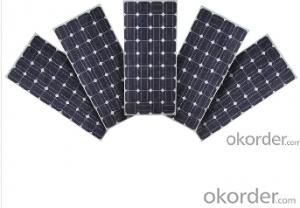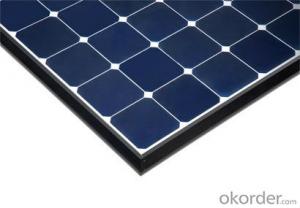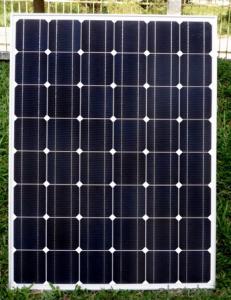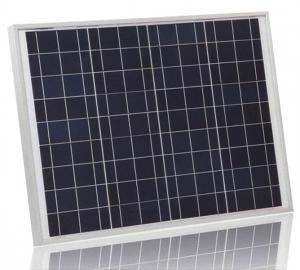Tin Solar Panels - CNBM Poly Solar Panel 300W A Grade with Factory Price
- Loading Port:
- Shanghai
- Payment Terms:
- TT OR LC
- Min Order Qty:
- 24 watt
- Supply Capability:
- 100000 watt/month
OKorder Service Pledge
OKorder Financial Service
You Might Also Like
Specification
CNBM Poly Solar Panel 300W A Grade with Factory Price
Production description
solar panels that can always be pointed at the Sun even as the rest of the body of the spacecraft moves around, much as a tank turret can be aimed independently of where the tank is going.
Each module is rated by its DC output power under standard test conditions, and typically ranges from 100 to 365 watts. The efficiency of a module determines the area of a module given the same rated output – an 8% efficient 230 watt module will have twice the area of a 16% efficient 230 watt module.
Depending on construction, photovoltaic modules can produce electricity from a range of frequencies of light, but usually cannot cover the entire solar range (specifically, ultraviolet, infrared and low or diffused light). Hence, much of the incident sunlight energy is wasted by solar modules, and they can give far higher efficiencies if illuminated with monochromatic light. Therefore, another design concept is to split the light into different wavelength ranges and direct the beams onto different cells tuned to those ranges.[citation needed] This has been projected to be capable of raising efficiency by 50%. Scientists from Spectrolab, a subsidiary of Boeing, have reported development of multijunction solar cells with an efficiency of more than 40%, a new world record for solar photovoltaic cells.
Currently the best achieved sunlight conversion rate (solar module efficiency) is around 21.5% in new commercial products[3] typically lower than the efficiencies of their cells in isolation. The most efficient mass-produced solar modules[disputed – discuss] have power density values of up to 175 W/m2(16.22 W/ft2).[4] Research by Imperial College, London has shown that the efficiency of a solar panel can be improved by studding the light-receiving semiconductor surface with aluminum nanocylinders similar to the ridges on Lego blocks. The scattered light then travels along a longer path in the semiconductor which means that more photons can be absorbed and converted into current. Although these nanocylinders have been used previously (aluminum was preceded by gold and silver), the light scattering occurred in the near infrared region and visible light was absorbed strongly. Aluminum was found to have absorbed the ultraviolet part of the spectrum, while the visible and near infrared parts of the spectrum were found to be scattered by the aluminum surface. This, the research argued, could bring down the cost significantly and improve the efficiency as aluminum is more abundant and less costly than gold and silver. The research also noted that the increase in current makes thinner film solar panels technically feasible without "compromising power conversion efficiencies, thus reducing material consumption".[5]

Application
Aerospace
Residential
Commercial
Large solar power plant
Distributed plant
Product Feature
1.A grade high efficiency solar cells.
2.TUV/UL/CE/CEC etc
3.Fast shippment
4.25 years warranty
5.OEM
Package
24pcs into one carton, 312pcs into a 20 foot container, 728pcs into a 40 foot container.
- Q: solar panels!!they are fantastic! cause they are the new way of quot;chargingyour home, without killing the earth!would you install them, or not? and make sure you say WHY
- Why: ) It's a great technology. 2) It has low impact to the environment. Why Not: ) Initial cost is substantial. 2) solar panel technology is greatly improving. I would hold out for a few more years when you can actually use it as a sustainable source and as a replacement source and not so much a suplimentary source.
- Q: Solar panels are costly.Do you know any inexpensive way?So that i can make one of my own.
- Solar things are always costly... You can use concave mirrors and concentrate the heat and heat what and then steam ll be formed and then steam directed to turbines, there you go generating electricity with out solar panels...
- Q: do solar panels create electricity from the ultraviolet light created from the sun? because they only have an efficientcy of like 8% and this scientist found out a way to collect the visible light also, and he says the solar panel could have an effeciency of up to 80%! so my question really is, do solar penels creat electricity from heat? do you know of anything that can?
- Solar panels create a current from light. A photon strikes a crystal lattice and anelectron is freed and flows as a current
- Q: Can solar panels be installed on swimming pools?
- Yes, solar panels can be installed on swimming pools. Solar panels can help to power pool pumps, heaters, and other equipment, reducing energy costs and making pools more energy-efficient.
- Q: ok so when a solar panel is marked as a certain wattage dose that mean it makes that much in a day in an hour or constant, dose it still work at night or what ? is it worth it or is it more of a pain? can some one tell me what all the watts and volts mean ?? and can some one tell me what a kilowhat is in refrence to some thing i understand like howmany loads of laundey can you do wt a watt? i need help understanding this stuff?
- You okorder /
- Q: Can solar panels be installed on a flat roof?
- Yes, solar panels can be installed on a flat roof. Flat roofs are actually a popular choice for solar panel installations because they provide an ideal surface for mounting the panels. The panels can be mounted using ballasted systems, which don't require any penetrations into the roof. This makes the installation process easier and minimizes any potential damage to the roof.
- Q: i am starting to consider getting solar panels instead of paying electric bills which are somewhat higher now than they used to be
- Budget okorder /
- Q: how big of an solar panel do i need to power/charge my laptop?would one from canadian tire sell the right one?
- Yes. Basically, here's what you need (I'm keeping this general on purpose): The panels themselves -- how large an area depends on average power consumption and how much power you can get on average. That, in turn , depends on climate. You'd need more in Seattle than Tuscon, for example. I'd guess something in the neighborhod of 0 square feet. Depends also on haow many gadgets (printers, etc.) you have. You'll need a power storage system. Lithium gives you the best poser density (of off-the-shelf stuff) but an ordinary car battery works well and is reliable. And, of course, a control system to manage the power generation/storage/use so everything works together without that annoying smell that tells you you just cooked a few hundred bucks worth of equuipment! :)
- Q: Can solar panels be used for powering security systems?
- Yes, solar panels can be used to power security systems. Solar panels convert sunlight into electricity, providing a sustainable and reliable source of power for various applications, including security systems. By harnessing solar energy, security systems can operate efficiently and independently without relying on traditional electrical grids.
- Q: How do solar panels impact the local job market?
- Solar panels have a positive impact on the local job market as they create new employment opportunities in the renewable energy sector. The installation, maintenance, and manufacturing of solar panels require skilled workers, which leads to job growth and economic development in the community. Additionally, the transition to solar energy promotes a shift towards clean energy sources, attracting more investments and creating a sustainable job market for the future.
Send your message to us
Tin Solar Panels - CNBM Poly Solar Panel 300W A Grade with Factory Price
- Loading Port:
- Shanghai
- Payment Terms:
- TT OR LC
- Min Order Qty:
- 24 watt
- Supply Capability:
- 100000 watt/month
OKorder Service Pledge
OKorder Financial Service
Similar products
Hot products
Hot Searches























